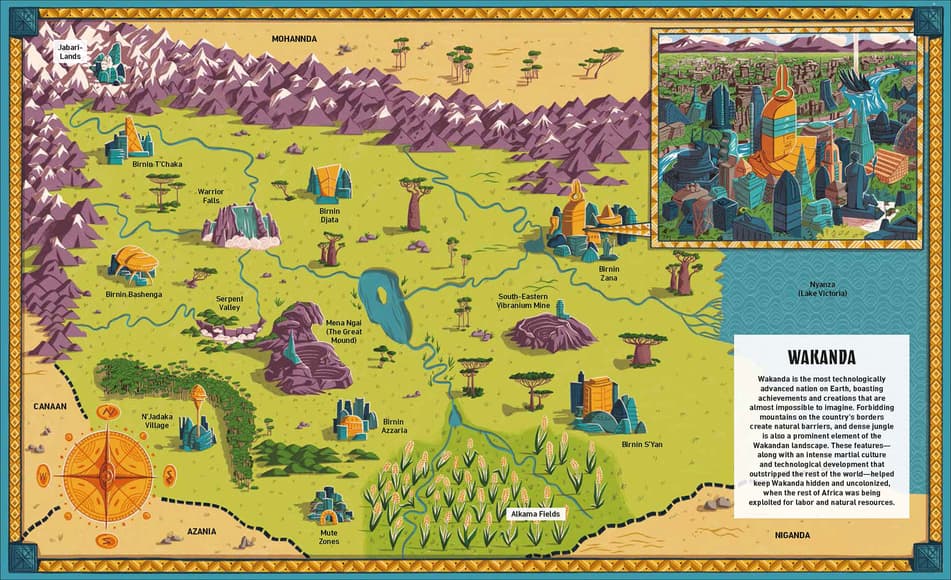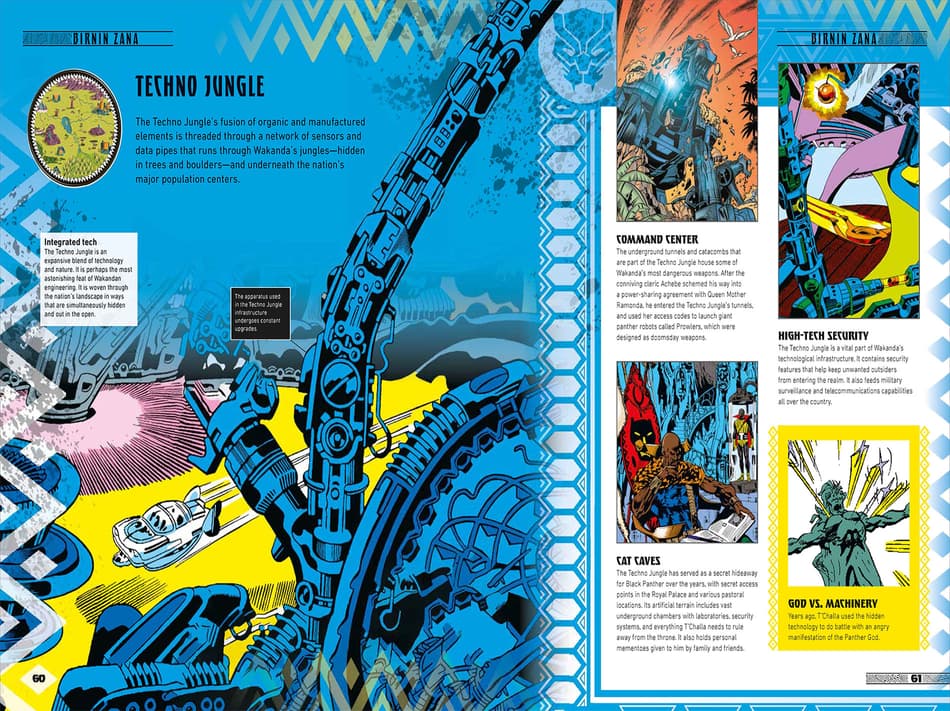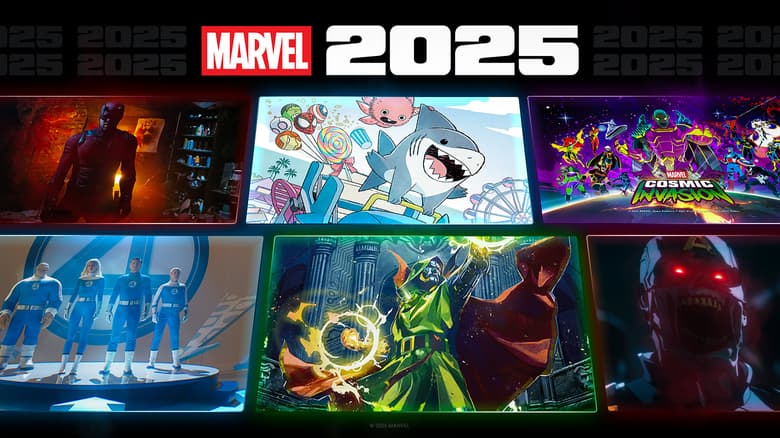Your Definitive Guide to Wakanda: The Marvel Black Panther Wakanda Atlas Is Available Now
We dive deep into Wakanda’s history and culture with Atlas creator and ‘Rise of the Black Panther’ writer Evan Narcisse.
ORDER THE MARVEL BLACK PANTHER WAKANDA ATLAS FROM DK BOOKS!
For many of us, the kingdom of Wakanda is a place we’ve envisioned from comics and the screen. But now, the Marvel Black Panther Wakanda Atlas from DK Books allows you to hold the entire nation, and its ever-expanding history, in your hands.

Written by journalist and comics and video games writer Evan Narcisse—with newly commissioned art from Shawn Martinbrough—the Marvel Black Panther Wakanda Atlas is a reader’s definitive guide to the landscape, legacy, and inner workings of a technologically advanced nation on the continual brink of change.
“Treating Wakanda itself like a character that would become more complicated and layered—and sometimes contradictory—was how I approached writing the book,” says Narcisse on the Atlas’ development. “I love the idea that there's a lot of different ways of living in Wakanda.”
Chock-full of intricate maps, key battlegrounds and timelines, essays, and captivating imagery, the Atlas brings the world of Wakanda to life in stunning, new detail. It also offers insight into major locations from Black Panther comics, such as Birnin Zana, the Golden City, the Great Mound and the Necropolis. Readers will learn about the importance of these locations for T'Challa, Shuri, the Dora Milaje, the Avengers, and more, while taking in breathtaking views of waterfalls, jungles, laboratories, the Royal Palace, and even the meteorite site that became the nation’s secret source of Vibranium.
We sat down with Evan Narcisse to cover his current work at Marvel plus all things Wakanda—its history, its people, and, of course, an ancient lineage of Black Panthers.
To get a little backstory, do you remember your first introduction to Black Panther as a character?
EVAN NARCISSE: So, I'm going off my memory here, but [I believe it was] MARVEL SUPER ACTION, which were the reprints they were doing in the 70s of older books. This one was reprinting AVENGERS (1963) #61, I want to say from [‘67-‘68]. But yeah, it was a story where the Avengers have to fight Ymir and Surtur, the Asgardian Frost and Fire Giants.
Black Panther was in it, and he just seemed really cool to me. It was John Buscema art. It made an impression to me because aside from him being Black, I thought his costume was really cool. He looked sleek and powerful, and even a little bit foreboding compared to the other characters on the team.
Yeah, and fully masked head to toe.
EVAN NARCISSE: Yes, yeah. He kind of looked like a dude you didn't want to mess with. And then, if I remember correctly, part of that issue takes place in Wakanda. And more importantly, he's pining away for his native country, right? He's missing the place where he came from, and that resonated for me. My parents were born in Haiti, and my mom raised us. And T’Challa talking about Wakanda reminded me of the way she would talk about Haiti. And that just felt familiar.
When building out the Atlas, what was your ground floor in? Were you more character or landscape oriented?
EVAN NARCISSE: I always start with character. But the approach I took with the Atlas was that Wakanda itself is a character, right? When we talk about storytelling in comics or other media, we talk about character arcs. Like how have events changed a person, their attitudes, their worldview, et cetera. And Wakanda is the same way. When it first appeared in FANTASTIC FOUR (1961) #52, it seemed like a smaller place.
There is still a sense of, I think, inherent majesty and history to it. And it seemed like T'Challa was mostly the architect of the technological transformation and change in Wakanda. But as more writers touch the mythos, it expands backwards, deeper into history, and then forwards out into the future and [even now] out into space.
And these places that are catalogs in the book, they play such important roles in the building of the Black Panther mythos, in T’Challa’s own personal history. But also, the other characters, who are his antagonists, his allies. Or, just regular folk from the kingdom, people who are not Super Heroes, but their fortunes rise and fall depending on whether there's too much rain in the Alkama Fields.
Like, there's that one story arc in [Ta-Nehisi Coates’] first run, where they find out about the threat of the Originators and the cabal of villains who are causing all this chaos, because it hasn't stopped raining in the Alkama Fields. And Storm flies up, like, “Yeah, this is not natural.” And that's a place evolving over the period of a run, right? And then touching the characters' lives, and playing a part in the storyline. So that's kind of how I looked at it.
And a lot of different responses to [the nation’s] sociopolitical status quo and the changes. To imagine Wakanda as a country, is to imagine it as a place where there is sometimes disharmony, sometimes there is a conflict. Even as they agree that they are a nation, they can disagree about what the best path forward is, what the best way to honor the ancestors is. Those kinds of things are all things we see in the real world, like sociocultural conversations.

Is there anything in the Atlas—a location or otherwise—that will be completely new to Wakandan lore?
EVAN NARCISSE: No, it's all based on stuff that's been published before. Mostly because-- my personal opinion is as we see these characters grow and become the central kind of elements of these new adaptations outside of comics, that just reinforces the importance of the comics as the primary sources. I think if you're going to change something about the characters and where they operate, and who they are, the comics are the best place for that.
How about anything from your RISE OF THE BLACK PANTHER series? Anything you established there that found its way in?
EVAN NARCISSE: You know, I think the Hatut Zeraze headquarters. I think “Rise” was the first place that appeared. I wanted to explore the Wakanda Design Group a little bit more too. It's something that, again, existed before I'd touched Black Panther. But the idea that it was this corporation/laboratory research facility is really cool to me. Where some of the most innovative technology on the planet is being iterated on.
So that was one-- and the idea that there were different labs across the country. This idea that a country that's fully fleshed out and has been isolated in developing on its own for all this time, of course has different pockets of specialties, right? But yeah, I'm mostly working inside of what's already been established and then I find new angles. That's what I like doing.
Let’s talk about this art. A lot of it is recognizably from the comics. Were there any pieces that were specially illustrated for the Atlas though?
EVAN NARCISSE: Yeah. So there's [the Birnin Zana Marketplace] spread that Shawn Martinbrough did. Shawn did, I think, three spreads that were new: the Wakandan Embassy, the Birnin Zana Marketplace, and he also did the Vibranium mines, a kind of long ant’s-eye view shot where you see the trains crisscrossing.
Shawn's contribution was great because the editors at [DK Books] asked me who we could reach out to for these new spreads. And Shawn was one of the first people that came to mind. He's one of my favorite comics artists; he's done a lot of Black Panther work in the past. And he has such a great design sense in terms of fashion, environment. And blending the traditional and the super advanced is something that you've got to be good at when you're rendering Wakanda, and he's so amazing at that. So I was just really happy with what he did.
Yeah, the marketplace spread is especially rich.
EVAN NARCISSE: Yes. And layered. Like there's stuff happening in the background, in the foreground. It feels like, hey, this is a real place that has its own life.

I imagine how much research and re-reading when into creating the Atlas: What are those comic runs that you’d recommend for new Black Panther readers?
EVAN NARCISSE: I mean, it sounds like I'm just hyping my own work. But RISE OF THE BLACK PANTHER (2018) was written as an entry point. If you're new to this stuff, that's a good place to start. I also think Nnedi Okorafor’s SHURI (2018) is really inviting because it gives you perspective on the Black Panther mythos, which is unique. The book starts with Shuri dealing with the absence of T'Challa and figuring out whether she should take the mantle up again, and what that looks like. And also, [Nnedi’s run] delves into Wakanda's relationships with the rest of the African continent. So I feel like that's a really good place to start.
What else? I also like the book that [Tochi Onyebuchi] did-- BLACK PANTHER LEGENDS (2021). It’s a kind of reimagining of T'Challa's childhood, and I thought that was really strong. You get to see T'Challa grow into a sense of history and responsibility.
Yeah, that's mostly the modern stuff. I also think “Panther's Rage” is such a great storyline. It's dated, and modern readers may not necessarily vibe with the storytelling style at first, but it's so important because it grows the cast of characters in the Black Panther mythos. And also, the sense of Wakanda as a country, where there's political turmoil and churn. Plus the Wakandan national psyche gets established in that run: We're hostile to outsiders. They have concerns about their king gallivanting all around the world and adventuring with the Avengers. So I think that run is important.

You’re also writing the “History of the Black Panthers” story in WAKANDA (2022). What’s your experience on that series been like? Working with Natacha Bustos must make for a great collaboration!
EVAN NARCISSE: So amazing. When I got told that she was going to be the artist for “History of the Black Panthers,” I was so happy because I had already thought up the framing sequence, where Ramonda is leading a group of kids on the tour through the Haven of Heroes, and I had imagined this amazing statuary display.
A lot of readers will know Natacha from her MOON GIRL AND DEVIL DINOSAUR (2015) run. And she draws kids so well, all that infectious and chaotic cartoonish energy. But also, she can do really impressive Super Hero visual language too. And those are two things which I'd hoped to have intertwined throughout this story, and she just hit it out of the park.
WAKANDA is [a great series], I think, because the thing about the Black Panther mythos is so many of these characters can be central figures in their own stories, right? Like Shuri, M’Baku, Killmonger. All these characters really are compelling and have depth.
And I think focusing on these individuals and solo stories in each issue is great because I want to know more! I can't wait to see where [writer] Stephanie Williams takes the Shuri story, and that beautiful scene where Shuri and Ramonda are talking and Ramonda is being a mom. She's like, "Well, have you eaten?"
So often, in these big Super Hero story arcs, those small personal moments don't get prioritized. So this is a chance to prioritize that. And in WAKANDA (2022) #2, which I co-wrote with Adam Serwer, it's like what's happening in the Intergalactic Empire [of Wakanda]? We haven't gone back there in a minute. They just threw off like an evil regime. How do you rebuild after that? What is the vision? So that's something we want to revisit.
And in terms of the “History of the Black Panthers” back-up story, I'm not going to lie, that was a daunting task to try and walk through Wakandan history and spotlight these major players. But I also had a lot of fun doing it. Characters like Nehanda or Benhazin; we only caught glimpses of them throughout the years in different Black Panther series. So getting to spotlight important moments in those characters' lives, and where they're intertwined with the history of Wakanda was something that I was-- again, I kind of think of that as my jam.
But yeah, having Natacha as a partner-- that was great. And Jordie Bellaire on the colors was just like… Man, let me tell you something. If there's one revelation I've had in my comics career it’s that coloring is magic. The way it changes the way a scene can read. The way colors can draw your eye across the page, it's a really underappreciated art. And I think Jordie is one of the best people doing it nowadays, and I was so glad to have her be the colorist on this run.

Can we talk a bit about some of the Black Panther mythos you’ve established in Marvel video games too?
EVAN NARCISSE: Yeah, I did some work on the Black Panther game that Skydance New Media is making, which was announced at D23 last month. And, again, that's another chance to revisit the history of the Black Panther mantle.
I'm really excited for people to experience when the game comes out; it’s going to be a little while though. But it's just good to see T'Challa and all the other Black Panthers throughout history. It's good to see them thriving, and more of this history being created and revealed. I'm just happy to be a small part of it.
[RELATED: Watch D23 Expo 2022's Disney & Marvel Games Showcase Livestream]
Plus you worked on the narrative in Marvel’s Avengers DLC “War for Wakanda,” right?
EVAN NARCISSE: Yeah. And that was fun. Chris Judge as the voice of T'Challa was just amazing. I remember doing press interviews with him right before it launched. And just getting to hear that voice for four or six hours a day was like wow, I feel humbled, like you're in the presence of godhood and royalty. But also just really a cool ass dude.
Wrapping things up with a tough one: If you could spend anywhere in Wakanda for an entire day, where would you drop yourself?
EVAN NARCISSE: Wow. I mean, I know where I wouldn't want to be dropped in. Probably the Crystal Forest and the Jabari-Lands. It just always seems so foreboding and scary. Like you take a wrong turn, and a shard of crystal cuts your arm or something. It's just bad news, I think…
The Great Mound is the obvious answer because it's so significant. But-- oh man. Probably the Techno Jungle. Because I've always imagined it as this almost arterial infrastructure that spreads throughout the whole country, like the way we have our energy power lines and whatnot, going underground and above ground. I think of the Techno Jungle as the same thing. It's like this network of blood vessels. So watching the flow of information and energy crisscross across the country would be really cool.
I mean, the Royal Palace because there's going to be history and technology, plus all the personalities and the debates…
Or, maybe the Tribal Council Chambers because you just get to see people from different parts of the country argue with each other about “No, we need this, we need that.” So yeah. That's four answers in one!

Grab your copy of the Marvel Black Panther Wakanda Atlas, and pick up WAKANDA (2022) #1 in print and digital comic shops now!
The Daily Bugle
Can’t-miss news and updates from across the Marvel Universe!







